belt MERCEDES-BENZ G500 2002 W463 Owner's Manual
[x] Cancel search | Manufacturer: MERCEDES-BENZ, Model Year: 2002, Model line: G500, Model: MERCEDES-BENZ G500 2002 W463Pages: 385, PDF Size: 30.37 MB
Page 4 of 385

1 Contents
IntroductionProduct information .......................... 7
Roadside assistance ......................... 10
Where to find it ................................ 14
Reporting Safety Defects ................ 16Instruments and controlsInstruments and controls ............... 18
Center console .............................. 20
Door control panel ....................... 22
Overhead control panel ............... 23OperationVehicle keys ...................................... 26
Start lock-out .................................... 28
General notes on the
central locking system ............... 28
Central locking system ................... 29
Radio frequency and
infrared remote control ............... 29
Locking and unlocking ................ 31Choosing global or
selective mode on
remote control ...............................31
Opening and closing windows
and sliding / pop-up roof
from outside ................................. 32
Panic button ................................. 33
Mechanical keys .......................... 33
Doors ................................................. 34
Locking and unlocking
driver’s door manually ............... 36
Tailgate .............................................. 37
Locking and unlocking
the tailgate manually .................. 38
Locking the tailgate separately . 39
Central locking switch .................... 40
Automatic central locking ............... 41
Emergency unlocking in
case of accident ........................... 41
Antitheft alarm system ................... 42
Tow-away alarm ............................... 43
Easy-entry/exit feature .................. 44
Front seat adjustment ..................... 45Synchronizing head restraints
and seat adjustment fore, aft ..... 47
Removal and installation of
front seat head restraints .......... 51
Seat heater, front ............................. 52
Seat heater, rear ............................... 54
Seat belts and
integrated restraint system ....... 56
Seat belts ........................................... 56
Seat belt nonusage
warning system ............................ 57
BabySmart
TM airbag
deactivation system .................... 63
Self-test BabySmart
TM without
special child seat installed ........ 63
Supplemental restraint system
(SRS) ............................................. 64
Emergency tensioning retractor
(ETR) ............................................. 65
Airbags .............................................. 66
Safety guidelines for the
seat belt, emergency
tensioning retractor and
airbag ............................................ 71
J_G463.book Seite 1 Mittwoch, 19. September 2001 8:06 08
Page 7 of 385

4 Contents
Instrument cluster displayMalfunction and indicator
lamps in the
instrument cluster ....................264
On-board diagnostic system .........265
Check engine malfunction
indicator lamp .............................265
Brake warning lamp ..................266
Supplemental restraint system
(SRS) indicator lamp ..................267
Fuel reserve warning .................268
ABS malfunction
indicator lamp .............................269
Electronic stability program
(ESP) — warning lamp ...............270
Seat belt nonusage
warning lamp .............................270
Malfunction and indicator lamp
in the center console ................ 271
AIRBAG OFF indicator lamp ..... 271Malfunction and warning
messages in the
multifunction display .............. 272
DISPLAY DEFECTIVE
(engine control unit) ................. 273
DISPLAY DEFECTIVE
(several systems) ....................... 273
BATTERY / ALTERNATOR ........274
ANTILOCK BRAKE SYSTEM .... 275
BRAKE ASSIST ............................276
BRAKE PAD WEAR .................... 277
BRAKE FLUID ............................ 277
PARKING BRAKE ....................... 278
SEAT BELT SYSTEM .................. 278
ELEC. STABIL. PROG.
(Electronic stability program) . 279
COOLANT
(coolant level) ............................. 280
COOLANT
(coolant temperature) ............... 281
ENGINE OIL LEVEL ................... 282LIGHTING SYSTEM ....................283
LIGHT SENSOR ...........................285
DOOR ...........................................285
TRUNK OPEN .............................286
HOOD ...........................................286
TELEPHONE – FUNCTION .......287
TELE AID .....................................287
WASHER FLUID .........................288
RESTRAINT SYSTEM .................289
KEY ...............................................289
FUEL RESERVE ..........................290
UNDERVOLTAGE ........................290
ELECTRONIC BRAKE BOOSTER
(EBB) ............................................ 291
ENGINE AIR FILTER .................. 291
TC SHIFT ....................................292
TC SHIFT CONDITIONS ............292
TC IN NEUTRAL .........................293
TRANSFER CASE .......................293
J_G463.book Seite 4 Mittwoch, 19. September 2001 8:06 08
Page 9 of 385

6 Contents
Vehicle careCleaning and care
of the vehicle .............................350
Power washer .............................. 351
Tar stains ..................................... 351
Paintwork, painted body
components ................................. 351
Engine cleaning ..........................352
Vehicle washing .........................352
Ornamental moldings ................352
Headlamps, taillamps,
turn signal lenses ......................352
Window cleaning ........................353
Wiper blades ...............................353
Light alloy wheels ......................353
Instrument cluster .....................353
Steering wheel and
gear selector lever ......................353
Cup holder ...................................354
Seat belts .....................................354Headliner .................................... 354
Upholstery .................................. 354
Hard plastic trim items ............. 354
Plastic and rubber parts ........... 354
Technical dataSpare parts service ....................... 356
Warranty coverage ........................ 356
Identification labels ...................... 357
Layout of poly-V-belt drive ........... 358
Technical data ................................ 359
Fuels, coolants, lubricants etc. –
capacities ................................... 361
Engine oils ...................................... 363
Engine oil additives ...................... 363
Air conditioner refrigerant .......... 363
Brake fluid ...................................... 363
Premium unleaded gasoline ........ 364
Fuel requirements ........................ 364
Gasoline additives ......................... 365
Coolants .......................................... 365
Consumer information ................. 367
IndexIndex ................................................369
J_G463.book Seite 6 Mittwoch, 19. September 2001 8:06 08
Page 16 of 385
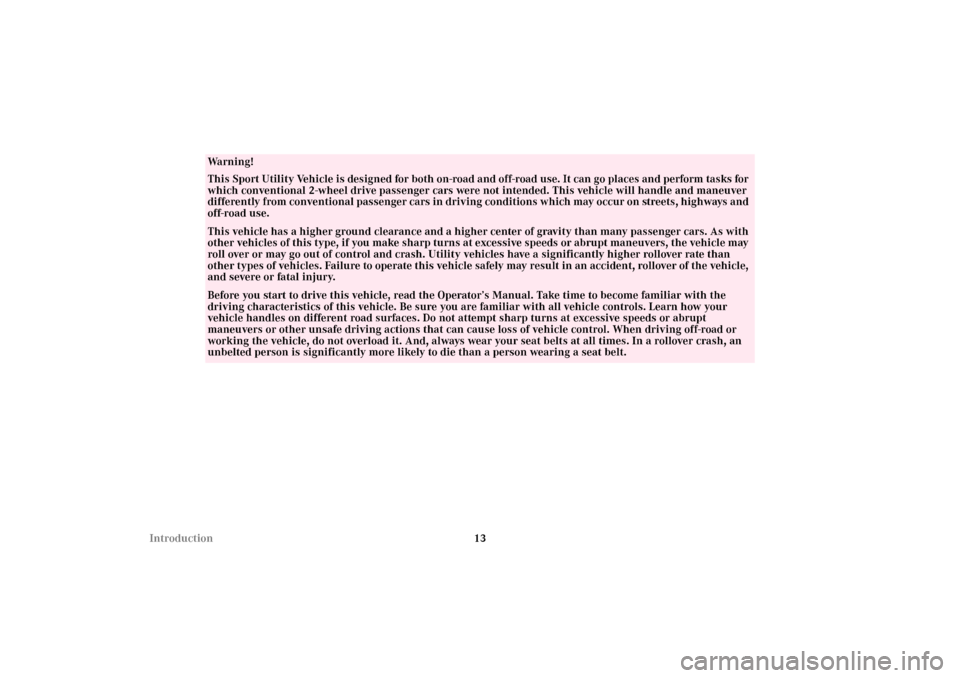
13 Introduction
Wa r n i n g !
This Sport Utility Vehicle is designed for both on-road and off-road use. It can go places and perform tasks for
which conventional 2-wheel drive passenger cars were not intended. This vehicle will handle and maneuver
differently from conventional passenger cars in driving conditions which may occur on streets, highways and
off-road use.This vehicle has a higher ground clearance and a higher center of gravity than many passenger cars. As with
other vehicles of this type, if you make sharp turns at excessive speeds or abrupt maneuvers, the vehicle may
roll over or may go out of control and crash. Utility vehicles have a significantly higher rollover rate than
other types of vehicles. Failure to operate this vehicle safely may result in an accident, rollover of the vehicle,
and severe or fatal injury.Before you start to drive this vehicle, read the Operator’s Manual. Take time to become familiar with the
driving characteristics of this vehicle. Be sure you are familiar with all vehicle controls. Learn how your
vehicle handles on different road surfaces. Do not attempt sharp turns at excessive speeds or abrupt
maneuvers or other unsafe driving actions that can cause loss of vehicle control. When driving off-road or
working the vehicle, do not overload it. And, always wear your seat belts at all times. In a rollover crash, an
unbelted person is significantly more likely to die than a person wearing a seat belt.
J_G463.book Seite 13 Mittwoch, 19. September 2001 8:06 08
Page 27 of 385
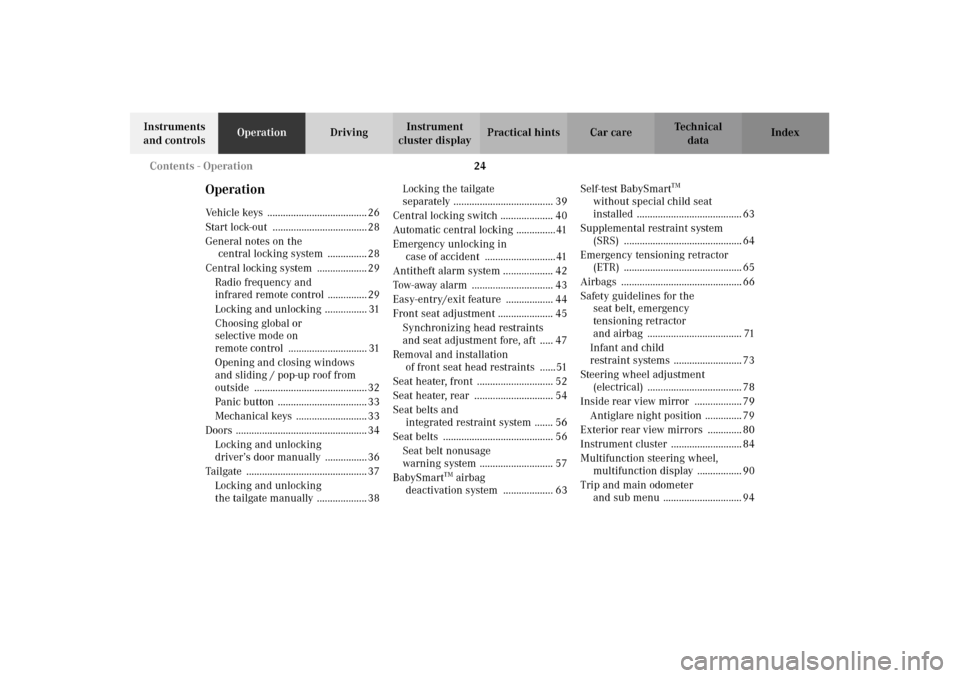
24 Contents - Operation
Te ch n i c a l
data Instruments
and controlsOperationDrivingInstrument
cluster displayPractical hints Car care Index
OperationVehicle keys ...................................... 26
Start lock-out .................................... 28
General notes on the
central locking system ............... 28
Central locking system ................... 29
Radio frequency and
infrared remote control ............... 29
Locking and unlocking ................ 31
Choosing global or
selective mode on
remote control .............................. 31
Opening and closing windows
and sliding / pop-up roof from
outside ........................................... 32
Panic button .................................. 33
Mechanical keys ........................... 33
Doors .................................................. 34
Locking and unlocking
driver’s door manually ................ 36
Tailgate .............................................. 37
Locking and unlocking
the tailgate manually ................... 38Locking the tailgate
separately ...................................... 39
Central locking switch .................... 40
Automatic central locking ............... 41
Emergency unlocking in
case of accident ........................... 41
Antitheft alarm system ................... 42
Tow-away alarm ............................... 43
Easy-entry/exit feature .................. 44
Front seat adjustment ..................... 45
Synchronizing head restraints
and seat adjustment fore, aft ..... 47
Removal and installation
of front seat head restraints ......51
Seat heater, front ............................. 52
Seat heater, rear .............................. 54
Seat belts and
integrated restraint system ....... 56
Seat belts .......................................... 56
Seat belt nonusage
warning system ............................ 57
BabySmart
TM airbag
deactivation system ................... 63Self-test BabySmart
TM
without special child seat
installed ........................................ 63
Supplemental restraint system
(SRS) ............................................. 64
Emergency tensioning retractor
(ETR) ............................................. 65
Airbags .............................................. 66
Safety guidelines for the
seat belt, emergency
tensioning retractor
and airbag .................................... 71
Infant and child
restraint systems .......................... 73
Steering wheel adjustment
(electrical) .................................... 78
Inside rear view mirror .................. 79
Antiglare night position .............. 79
Exterior rear view mirrors ............. 80
Instrument cluster ........................... 84
Multifunction steering wheel,
multifunction display ................. 90
Trip and main odometer
and sub menu .............................. 94
J_G463.book Seite 24 Mittwoch, 19. September 2001 8:06 08
Page 48 of 385
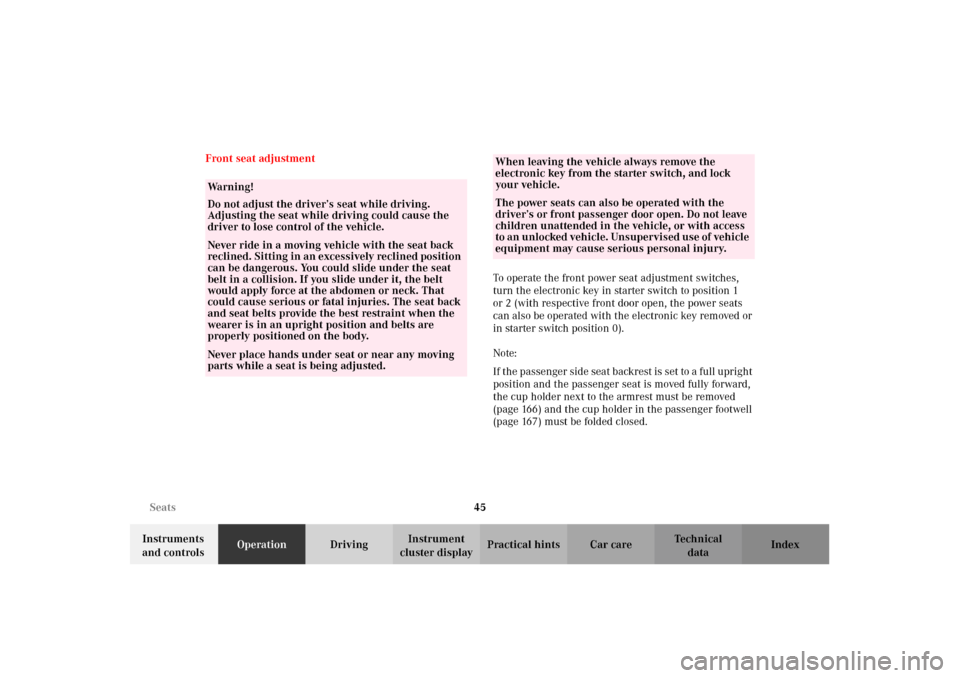
45 Seats
Te ch n i c a l
data Instruments
and controlsOperationDrivingInstrument
cluster displayPractical hints Car care Index Front seat adjustment
To operate the front power seat adjustment switches,
turn the electronic key in starter switch to position 1
or 2 (with respective front door open, the power seats
can also be operated with the electronic key removed or
in starter switch position 0).
Note:
If the passenger side seat backrest is set to a full upright
position and the passenger seat is moved fully forward,
the cup holder next to the armrest must be removed
(page 166) and the cup holder in the passenger footwell
(page 167) must be folded closed.
Wa r n i n g !
Do not adjust the driver’s seat while driving.
Adjusting the seat while driving could cause the
driver to lose control of the vehicle.Never ride in a moving vehicle with the seat back
reclined. Sitting in an excessively reclined position
can be dangerous. You could slide under the seat
belt in a collision. If you slide under it, the belt
would apply force at the abdomen or neck. That
could cause serious or fatal injuries. The seat back
and seat belts provide the best restraint when the
wearer is in an upright position and belts are
properly positioned on the body.Never place hands under seat or near any moving
parts while a seat is being adjusted.
When leaving the vehicle always remove the
electronic key from the starter switch, and lock
your vehicle. The power seats can also be operated with the
driver’s or front passenger door open. Do not leave
children unattended in the vehicle, or with access
to an unl ocked vehic l e. Uns upervi s ed us e of vehi cl e
equipment may cause serious personal injury.
J_G463.book Seite 45 Mittwoch, 19. September 2001 8:06 08
Page 53 of 385
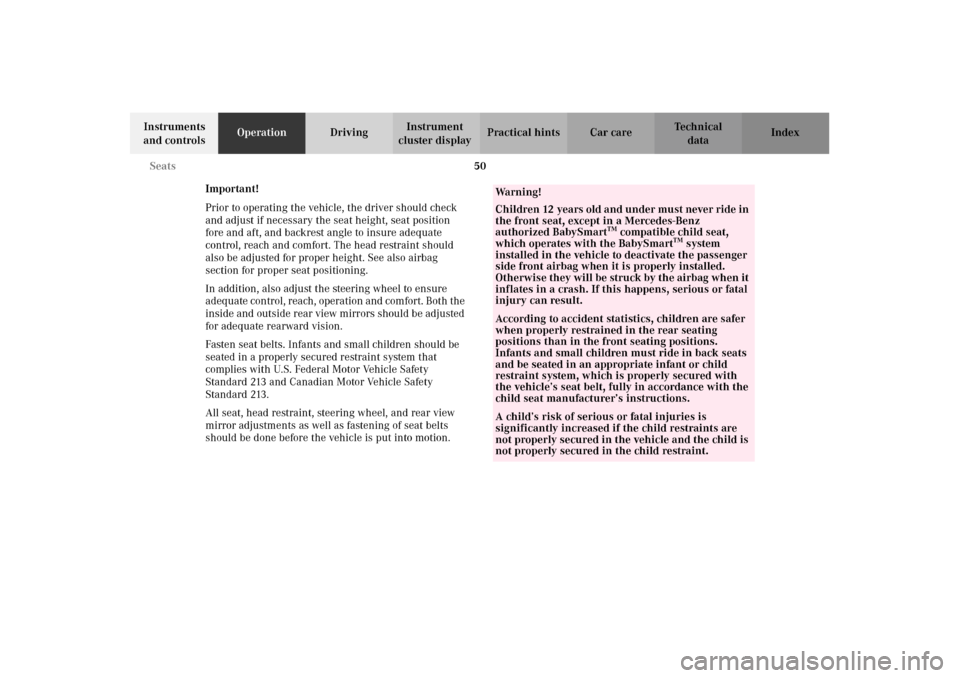
50 Seats
Te ch n i c a l
data Instruments
and controlsOperationDrivingInstrument
cluster displayPractical hints Car care Index
Important!
Prior to operating the vehicle, the driver should check
and adjust if necessary the seat height, seat position
fore and aft, and backrest angle to insure adequate
control, reach and comfort. The head restraint should
also be adjusted for proper height. See also airbag
section for proper seat positioning.
In addition, also adjust the steering wheel to ensure
ad eq uate con tr ol, r each, operation and com fort. B ot h the
inside and outside rear view mirrors should be adjusted
for adequate rearward vision.
Fasten seat belts. Infants and small children should be
seated in a properly secured restraint system that
complies with U.S. Federal Motor Vehicle Safety
Standard 213 and Canadian Motor Vehicle Safety
Standard 213.
All seat, head restraint, steering wheel, and rear view
mirror adjustments as well as fastening of seat belts
should be done before the vehicle is put into motion.
Wa r n i n g !
Children 12 years old and under must never ride in
the front seat, except in a Mercedes-Benz
authorized BabySmart
TM compatible child seat,
which operates with the BabySmart
TM system
installed in the vehicle to deactivate the passenger
side front airbag when it is properly installed.
Otherwise they will be struck by the airbag when it
inflates in a crash. If this happens, serious or fatal
injury can result.
According to accident statistics, children are safer
when properly restrained in the rear seating
positions than in the front seating positions.
Infants and small children must ride in back seats
and be seated in an appropriate infant or child
restraint system, which is properly secured with
the vehicle’s seat belt, fully in accordance with the
child seat manufacturer’s instructions.A child’s risk of serious or fatal injuries is
significantly increased if the child restraints are
not properly secured in the vehicle and the child is
not properly secured in the child restraint.
J_G463.book Seite 50 Mittwoch, 19. September 2001 8:06 08
Page 59 of 385
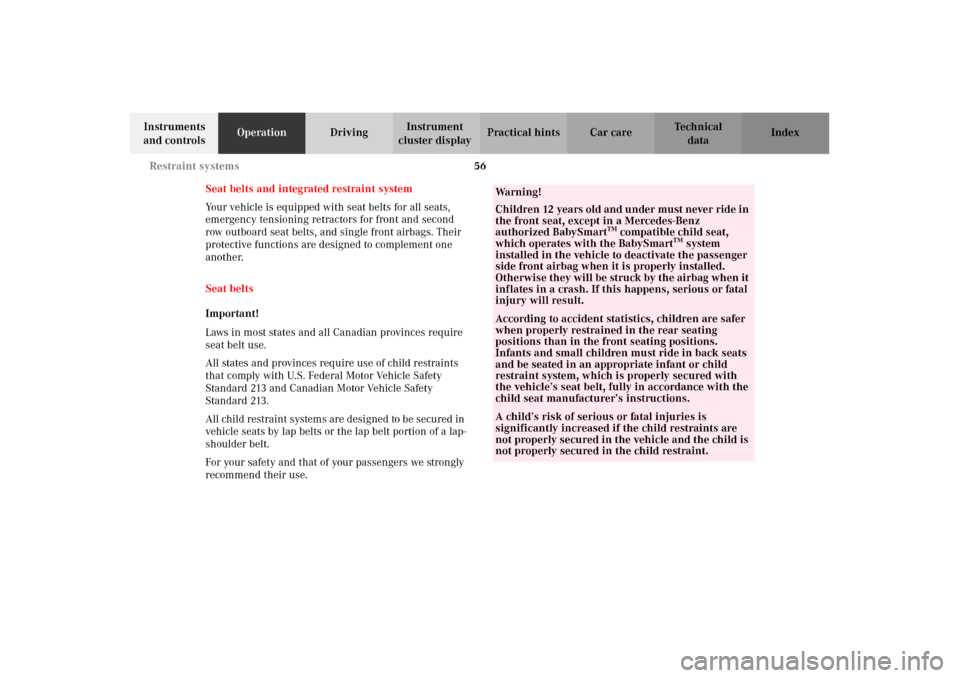
56 Restraint systems
Te ch n i c a l
data Instruments
and controlsOperationDrivingInstrument
cluster displayPractical hints Car care Index
Seat belts and integrated restraint system
Your vehicle is equipped with seat belts for all seats,
emergency tensioning retractors for front and second
row outboard seat belts, and single front airbags. Their
protective functions are designed to complement one
another.
Seat belts
Important!
Laws in most states and all Canadian provinces require
seat belt use.
All states and provinces require use of child restraints
that comply with U.S. Federal Motor Vehicle Safety
Standard 213 and Canadian Motor Vehicle Safety
Standard 213.
All child restraint systems are designed to be secured in
vehicle seats by lap belts or the lap belt portion of a lap-
shoulder belt.
For your safety and that of your passengers we strongly
recommend their use.
Wa r n i n g !
Children 12 years old and under must never ride in
the front seat, except in a Mercedes-Benz
authorized BabySmart
TM compatible child seat,
which operates with the BabySmart
TM system
installed in the vehicle to deactivate the passenger
side front airbag when it is properly installed.
Otherwise they will be struck by the airbag when it
inflates in a crash. If this happens, serious or fatal
injury will result.
According to accident statistics, children are safer
when properly restrained in the rear seating
positions than in the front seating positions.
Infants and small children must ride in back seats
and be seated in an appropriate infant or child
restraint system, which is properly secured with
the vehicle’s seat belt, fully in accordance with the
child seat manufacturer’s instructions.A child’s risk of serious or fatal injuries is
significantly increased if the child restraints are
not properly secured in the vehicle and the child is
not properly secured in the child restraint.
J_G463.book Seite 56 Mittwoch, 19. September 2001 8:06 08
Page 60 of 385
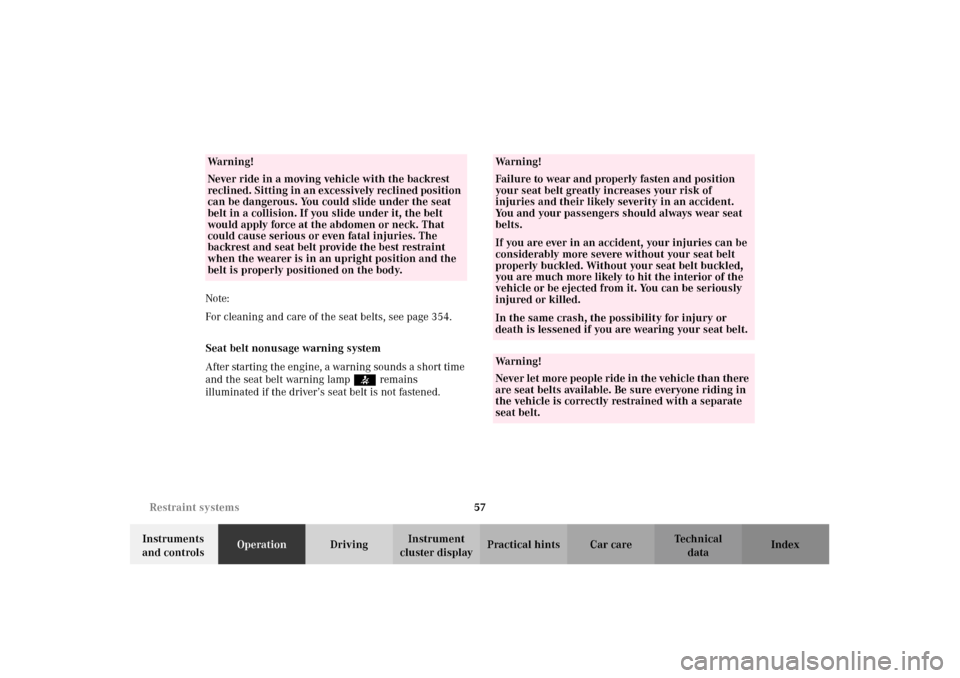
57 Restraint systems
Te ch n i c a l
data Instruments
and controlsOperationDrivingInstrument
cluster displayPractical hints Car care Index Note:
For cleaning and care of the seat belts, see page 354.
Seat belt nonusage warning system
After starting the engine, a warning sounds a short time
and the seat belt warning lamp< remains
illuminated if the driver’s seat belt is not fastened.
Wa r n i n g !
Never ride in a moving vehicle with the backrest
reclined. Sitting in an excessively reclined position
can be dangerous. You could slide under the seat
belt in a collision. If you slide under it, the belt
would apply force at the abdomen or neck. That
could cause serious or even fatal injuries. The
backrest and seat belt provide the best restraint
when the wearer is in an upright position and the
belt is properly positioned on the body.
Wa r n i n g !
Failure to wear and properly fasten and position
your seat belt greatly increases your risk of
injuries and their likely severity in an accident.
You and your passengers should always wear seat
belts.If you are ever in an accident, your injuries can be
considerably more severe without your seat belt
properly buckled. Without your seat belt buckled,
you are much more likely to hit the interior of the
vehicle or be ejected from it. You can be seriously
injured or killed.In the same crash, the possibility for injury or
death is lessened if you are wearing your seat belt.Wa r n i n g !
Never let more people ride in the vehicle than there
are seat belts available. Be sure everyone riding in
the vehicle is correctly restrained with a separate
seat belt.
J_G463.book Seite 57 Mittwoch, 19. September 2001 8:06 08
Page 61 of 385
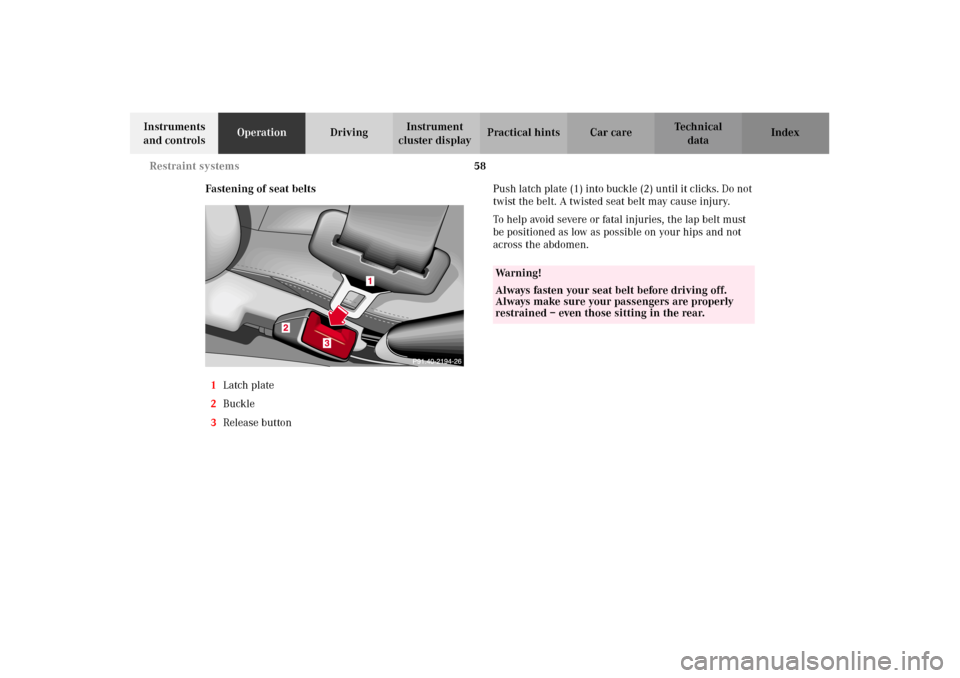
58 Restraint systems
Te ch n i c a l
data Instruments
and controlsOperationDrivingInstrument
cluster displayPractical hints Car care Index
Fastening of seat belts
1Latch plate
2Buckle
3Release buttonPush latch plate (1) into buckle (2) until it clicks. Do not
twist the belt. A twisted seat belt may cause injury.
To help avoid severe or fatal injuries, the lap belt must
be positioned as low as possible on your hips and not
across the abdomen.
Wa r n i n g !
Always fasten your seat belt before driving off.
Always make sure your passengers are properly
restrained – even those sitting in the rear.
J_G463.book Seite 58 Mittwoch, 19. September 2001 8:06 08